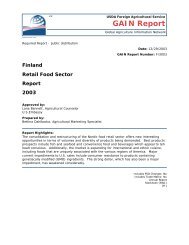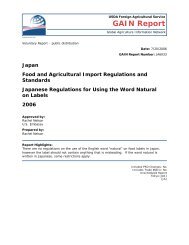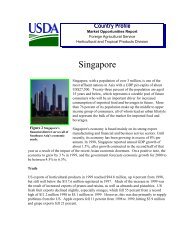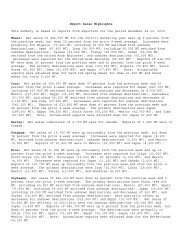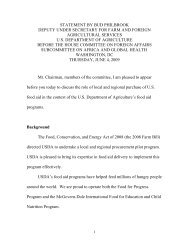Egypt - Foreign Agricultural Service
Egypt - Foreign Agricultural Service
Egypt - Foreign Agricultural Service
You also want an ePaper? Increase the reach of your titles
YUMPU automatically turns print PDFs into web optimized ePapers that Google loves.
Template Version 2.09<br />
Required Report - Public distribution<br />
EG9002<br />
<strong>Egypt</strong><br />
Grain and Feed<br />
Annual<br />
2009<br />
Approved by:<br />
Peter Kurz<br />
U.S. Embassy<br />
Prepared by:<br />
Cynthia I.Guven & Sherif Ibrahim<br />
USDA <strong>Foreign</strong> <strong>Agricultural</strong> <strong>Service</strong><br />
GAIN Report<br />
Global Agriculture Information Network<br />
Date: 3/10/2009<br />
GAIN Report Number: EG9002<br />
Report Highlights:<br />
Planted area for wheat in 2008/09 is forecast to decrease slightly from the previous year's<br />
level as a result of the decrease in wheat prices. The Russian market share in the <strong>Egypt</strong>ian<br />
wheat market increased, while the U.S. market share decreased. With 76 percent market<br />
share, the U.S continues to dominate the <strong>Egypt</strong>ian corn market. As of February 21, 2009,<br />
the Ministry of Trade and Industry removed the ban on rice exports. <strong>Egypt</strong>'s total rice<br />
exports between February 21 and the end of July 2009 are expected to be 250,000 MT.<br />
Includes PSD Changes: Yes<br />
Includes Trade Matrix: Yes<br />
Annual Report<br />
Cairo [EG1]<br />
[EG]
GAIN Report - EG9002 Page 2 of 10<br />
Table of Contents<br />
WHEAT ...............................................................................................................3<br />
PS&D...............................................................................................................3<br />
Production .......................................................................................................3<br />
Consumption....................................................................................................4<br />
Trade ...............................................................................................................4<br />
Stock ...............................................................................................................5<br />
CORN..................................................................................................................6<br />
PS&D...............................................................................................................6<br />
Production .......................................................................................................6<br />
Consumption....................................................................................................6<br />
Trade ...............................................................................................................7<br />
RICE ...................................................................................................................8<br />
PS&D...............................................................................................................8<br />
Production .......................................................................................................8<br />
Consumption and Stocks ...................................................................................8<br />
Trade ...............................................................................................................9<br />
Export Policy....................................................................................................9<br />
UNCLASSIFIED USDA <strong>Foreign</strong> <strong>Agricultural</strong> <strong>Service</strong>
GAIN Report - EG9002 Page 3 of 10<br />
WHEAT<br />
PS&D<br />
Wheat<br />
<strong>Egypt</strong><br />
2007/2008 2008/2009 2009/2010<br />
Market Year Begin: Jul 2007 Market Year Begin: Jul 2008 Market Year Begin: Jul 2009<br />
Annual Data<br />
Displayed<br />
New Annual Data<br />
New Annual Data Jan<br />
Post Displayed<br />
Post Displayed<br />
Data Data Data<br />
Area Harvested 1,287 1,287 1,287 1,290 1,288 1,226 1,223<br />
Beginning<br />
Stocks<br />
4,120 4,120 4,120 4,135 4,128 4,128 4,345<br />
Production 8,275 8,275 8,275 8,300 8,277 7,883 7,864<br />
MY Imports 7,700 7,528 8,310 7,800 7,540 8,320 8,325<br />
TY Imports 7,700 7,528 8,310 7,800 7,540 8,320 8,325<br />
TY Imp. from<br />
U.S.<br />
2,839 2,404 2,404 0 2,350 2,350 2,360<br />
Total Supply 20,095 19,923 20,705 20,235 19,945 20,331 20,534<br />
MY Exports 10 15 15 10 15 16 15<br />
TY Exports 10 15 15 10 15 16 15<br />
Feed<br />
Consumption<br />
50 60 60 50 60 70 70<br />
FSI<br />
Consumption<br />
15,900 15,720 16,502 16,000 15,870 15,900 15,864<br />
Total<br />
Consumption<br />
15,950 15,780 16,562 16,050 15,930 15,970 15,934<br />
Ending Stocks 4,135 4,128 4,128 4,175 4,000 4,345 4,585<br />
Total Distribution 20,095 19,923 20,705 20,235 19,945 20,331 20,534<br />
Production<br />
Wheat is planted in October/November and harvested in April/May. The total wheat area for<br />
MY 2007/2008 was 1.29 MHA, a small increase over MY 2006/07. For MY 2008/2009,<br />
Ministry of Agriculture experts forecast that planted area will decrease slightly from the<br />
2007/08 level as a result of the decrease in wheat prices. Total production for MY 2007/2008<br />
was 8.3 MMT or about the same as 2006/2007 level. The government has not announced the<br />
procurement price yet for the 2008/09 crop. According to government experts, it is expected<br />
to be around LE 1,800 per MT ($327), which is down from LE 2,533 per MT ($460 per MT) in<br />
2007/08. As a comparison, the current landed price for Russian wheat is about $172 per MT<br />
compared to $432 per MT in February 2008. The expected decrease in the government<br />
procurement price for wheat may reflect a bit negatively on wheat area in 2009/10.<br />
The <strong>Egypt</strong>ian milling industry has more than adequate capacity to cover the country’s need<br />
for 72 percent extraction flour. While total consumption of 72 percent extracted flour is<br />
estimated at 1.8 million tons or 2.5 million tons of wheat, total milling capacity is estimated<br />
at 2.7 million tons of 72 percent flour, or 3.76 million tons of wheat. The public sector milling<br />
industry consists of 126 mills (mostly small or medium size) and has a total capacity of<br />
approximately 7 million tons per year. There are seven public sector companies that operate<br />
these mills, and all are affiliated with one holding company (Food Industries Holding<br />
Company). Of the 126 public sector mills, 109 mills are currently used for the production of<br />
82 percent flour and 7 mills are used to produce 72 percent flour with total capacity of 6,230<br />
tons per day (1.86 million tons annually). Shares in some of these companies have been<br />
sold to private investors over the past few years. Although the majority of shares are held<br />
by the private sector, the holding company maintains complete control of these mills. Given<br />
UNCLASSIFIED USDA <strong>Foreign</strong> <strong>Agricultural</strong> <strong>Service</strong>
GAIN Report - EG9002 Page 4 of 10<br />
that wheat is a strategic commodity in <strong>Egypt</strong>, the government is expected to retain control of<br />
most of the milling industry (particularly for the subsidized baladi bread). There are nearly<br />
36 private sector commercial mills, with total capacity of 9,000 tons per day (2.8 million tons<br />
annually). These are permitted to produce 72 percent flour only. However, some private<br />
sector mills obtained approval to mill 82 percent flour for the government for a fee.<br />
Consumption<br />
<strong>Egypt</strong> continues to have one of the highest wheat per capita consumption levels in the world.<br />
Total consumption of wheat is forecast to be 16.5 and 15.9 million MT in 2007/08 and<br />
2008/09, respectively. Since the beginning of MY 2008/09 (July 2008) through the end of<br />
February 2009, the Ministry of Supply (GASC) purchased 4.5 MMT of imported wheat to<br />
produce 82 percent extraction flour used for the subsidized baladi bread. This represents<br />
about 1 MMT less quantity than was imported during the same period last year. This<br />
decrease in imports by GASC is mainly due to the increased purchases from local production.<br />
The total subsidy on baladi bread in MY 2007/08 is estimated at LE 9 billion. During the<br />
same period, private sector companies purchased 2 MMT of imported wheat to produce 72<br />
percent extraction flour used in the production of high quality flat bread and European type<br />
bread, pastries and pasta. Most of the domestic wheat crop is sold directly to consumers or<br />
retained by farmers for on-farm consumption.<br />
The total quantity of locally produced wheat sold to the Ministry of Industry and <strong>Foreign</strong><br />
Trade in 2007/08 was 2.5 million MT, compared to 1.7 million MT in 2006/07. This increase<br />
in GASC purchasing quantity results from the higher price offered to farmers by the<br />
government. The General Authority for Supply Commodities (GASC) has a target to<br />
purchase 3.5 million MT this year. Most observers suspect that GASC will once again not<br />
achieve its target since the private sector will continue to offer higher prices to the farmers.<br />
The balance of locally produced wheat either goes directly to consumers or is retained by<br />
farmers for on-farm consumption. <strong>Egypt</strong>ian per capita consumption of wheat in MY<br />
2007/2008 is expected to reach 195 kg.<br />
Trade<br />
<strong>Egypt</strong>’s total wheat imports are expected to increase during this marketing year (2008/09).<br />
Russia continues to be the largest wheat supplier to the <strong>Egypt</strong>ian market. From the<br />
beginning of MY 2008/09 through the end of February 2009, Russian exports accounted for<br />
54 percent or about 3 MMT of <strong>Egypt</strong>ian wheat imports. U.S. market share decreased in<br />
2008/09 from the previous year; U.S. market share continues to lag well below levels of a<br />
few years ago. From the beginning of MY 2008/09 through the end of February 2009, U.S.<br />
exports accounted for 29 percent or about1.5 MMT of wheat imports; the remainder was<br />
imported from Ukraine and Canada. It is expected that U.S. wheat exports to the <strong>Egypt</strong>ian<br />
market will increase through the end of MY 2008/09 since GASC is no longer purchasing<br />
locally from the private sector importers. GASC is only buying through international tenders.<br />
Although the ban on rice exports has been lifted, the <strong>Egypt</strong>ian Syrian barter deal currently<br />
remains suspended. Most private sector wheat traders import small cargoes from the Black<br />
Sea area. In its last tender, dated February 22, 2009, the Ministry of Supply purchased<br />
180,000 MT of wheat from Russia at a reported price of $172 per MT/FOB.<br />
For MY 2009/2010, <strong>Egypt</strong>ian wheat imports are expected to reach 8.3 MMT, with GASC<br />
projected to import nearly 6 MMT, and the rest to be imported by the private sector. This<br />
increase in GASC imports is expected because of the increased amount of wheat necessary<br />
for the production of 82 percent flour. Customs duties for wheat and corn are one percent<br />
plus two percent for other port charges.<br />
UNCLASSIFIED USDA <strong>Foreign</strong> <strong>Agricultural</strong> <strong>Service</strong>
GAIN Report - EG9002 Page 5 of 10<br />
Due to competition from other suppliers, notably Russia, the U.S. market share has declined<br />
in recent years. Nonetheless, both government and private sector buyers prefer U.S. wheat.<br />
However, due to prevailing market conditions, namely higher prices and freight for U.S.<br />
wheat, GASC and <strong>Egypt</strong>ian milling companies will likely continue to purchase lower quality<br />
wheat. Both sectors are now sourcing more wheat from non-U.S. origins such as Russia and<br />
Ukraine.<br />
U.S. Wheat Associates continues to provide trade servicing and quality seminars to <strong>Egypt</strong>ian<br />
millers, wheat buyers, and traders. Although the USDA GSM-102 program is available for<br />
both public and private sector importers of U.S. agricultural commodities, importers have not<br />
used the program in several years, citing the potential for exchange rate risk in the <strong>Egypt</strong>ian<br />
market. In addition, <strong>Egypt</strong>ian banks do not pass along benefits to importers.<br />
Import Trade Matrix<br />
<strong>Egypt</strong><br />
Wheat<br />
Time Period MY Units: My<br />
2006/07<br />
2007/08<br />
Imports for: 1<br />
U.S. 2,405 U.S. 2,840<br />
Others Others<br />
Russia 2,796 Russia 3,655<br />
Canada 602 Canada 188<br />
France 423 France 200<br />
Kazakhstan 420 Kazakhstan 860<br />
Ukraine 319 Ukraine 530<br />
Australia 188 Syria 37<br />
Syria 178<br />
Romania 96<br />
Bulgaria 46<br />
Total for<br />
Others<br />
Others not<br />
Listed<br />
5068 5470<br />
Grand Total<br />
Stocks?<br />
7473 8310<br />
The Ministry of Supply and Domestic Trade tries to maintain five months supply of strategic<br />
stocks. However, due to limited storage capacity that constrains the government from<br />
reaching this target, the strategic stocks are now redefined to include wheat import<br />
purchases in the pipeline, and usually amount to in the range of three months of annual<br />
consumption. Currently, total covered storage capacity for wheat is estimated at one million<br />
metric tons, including about 350,000 tons in silos at three different ports, 250,000 tons in<br />
inland silos and 400,000 tons in open storage, mostly in metropolitan areas. In addition to<br />
government storage facilities, several private sector traders and mills currently have their<br />
own receiving and storage facilities, estimated at 500,000 tons. In order to increase the<br />
storage capacity, the Ministry of Supply is currently promoting a project to encourage the<br />
private sector to build 50 inland silos each with 30,000 tons capacity in different locations<br />
UNCLASSIFIED USDA <strong>Foreign</strong> <strong>Agricultural</strong> <strong>Service</strong>
GAIN Report - EG9002 Page 6 of 10<br />
throughout the country. The Ministry of Social Welfare will commit to using 60 percent of the<br />
capacity of each silo’s capacity at the prevailing storage fee for five years.<br />
CORN<br />
PS&D<br />
Corn<br />
<strong>Egypt</strong><br />
2007 2008 2009<br />
2007/2008 2008/2009 2009/2010<br />
Market Year Begin: Oct 2007 Market Year Begin: Oct 2008 Market Year Begin: Oct 2009<br />
Annual Data<br />
Displayed<br />
New Annual Data<br />
New Annual Data Jan<br />
Post Displayed<br />
Post Displayed<br />
Data Data Data<br />
Area Harvested 720 720 720 725 725 730 735<br />
Beginning Stocks 920 670 670 845 665 593 442<br />
Production 6,174 6,174 6,174 6,175 6,175 6,217 6,260<br />
MY Imports 4,151 4,220 4,148 4,000 4,100 4,200 4,220<br />
TY Imports 4,151 4,220 4,148 4,000 4,100 4,200 4,220<br />
TY Imp. from U.S. 2,971 0 3,153 0 0 3,180 3,200<br />
Total Supply 11,245 11,064 10,992 11,020 10,940 11,010 10,922<br />
MY Exports 0 0 0 0 0 0 0<br />
TY Exports 0 0 0 0 0 0 0<br />
Feed Consumption 8,300 8,299 8,299 8,000 8,090 8,250 8,300<br />
FSI Consumption 2,100 2,100 2,100 2,300 2,300 2,318 2,320<br />
Total Consumption 10,400 10,399 10,399 10,300 10,390 10,568 10,620<br />
Ending Stocks 845 665 593 720 550 442 302<br />
Total Distribution 11,245 11,064 10,992 11,020 10,940 11,010 10,922<br />
Production<br />
The total corn area for MY 2008/2009 is estimated at 730,000 HA, slightly increased from<br />
the 2007/2008 level. The small increase in corn acreage is attributed to increasing demand<br />
in for corn silage as cheap feed for livestock. For the same reason, a further increase in corn<br />
acreage is expected in MY 2009/2010. The same factor is expected to lead farmers to switch<br />
from cotton to corn. In MY 2008/2009, total corn production is estimated at about 6.2 MMT.<br />
For MY 2009/2010, total corn production is expected to increase and reach 6.26 MMT.<br />
Consumption<br />
While total corn consumption did not change during the last two MY’s, corn consumption for<br />
feed in MY 2008/09 decreased slightly and is expected to start to bounce back in MY<br />
2009/10. In 2008/09 corn feed consumption is estimated at about 8.25 MMT, compared to<br />
8.29 MMT in the previous year. The majority of the local corn crop is utilized for animal feed<br />
(mostly consumed on farm) and about 1.5 million tons is used for food purposes (either<br />
milled or consumed fresh). Large commercial end-users and feed mills rely on imported<br />
yellow corn to meet their requirements.<br />
Corn use in feed is forecast to increase in 2009/10 and reach 8.3 MMT as the poultry<br />
industry situation improves from the outbreak of Avian Influenza (AI), which began in<br />
February 2006 and was followed by a severe temporary reduction in poultry output in 2006.<br />
In addition, there has been increased utilization of corn in the production of 20:80 cornwheat<br />
composite flour for baladi bread. In 2008/09, about 550,000 tons of locally produced<br />
white corn are expected to be delivered to the Ministry of Social Welfare for the production of<br />
UNCLASSIFIED USDA <strong>Foreign</strong> <strong>Agricultural</strong> <strong>Service</strong>
GAIN Report - EG9002 Page 7 of 10<br />
subsidized baladi bread. In 2009/10, total white corn delivery is expected to reach 600,000<br />
tons. In addition, there is a small, but growing demand for food products containing corn<br />
(snack foods) and corn oil.<br />
Trade<br />
Total corn imports for 2008/09 are expected to increase due to the increased demand in both<br />
the poultry and livestock sectors. Total corn imports since the beginning of MY 2008/09<br />
(October 2008) until the end of January 2009 are estimated at 823,634 MT compared to<br />
782,921 MT in the previous year. With 76 percent market share, the U.S continues to<br />
dominate the <strong>Egypt</strong>ian corn market. The U.S. market share in 2007/08 accounted for 76<br />
percent. Argentina’s market share has increased to 24 percent versus 16 percent in MY<br />
2006/07. However, the U.S market share is expected to recover in MY 2008/09, and<br />
accounted for 80 percent as of the end of December 2008. A further increase in corn<br />
imports is expected in MY 2009/10. Competition from Argentina and other suppliers of<br />
yellow corn should remain modest in MY 2009/10 as the price gap between the U.S. and<br />
other suppliers is expected to be marginal.<br />
Stocks<br />
Since both imported and locally produced corn just about covers the requirements for human<br />
consumption and animal feed, <strong>Egypt</strong> does not maintain any corn stocks.<br />
Import Trade Matrix<br />
Corn<br />
Time Period MY2006 Units: MY2007<br />
/07<br />
/08<br />
Imports for: 1<br />
U.S. 3,198 U.S. 3,152<br />
Others Others<br />
Argentina 689 Argentina 985<br />
Ukraine 170 Brazil 10<br />
New Zealand 70<br />
Total for<br />
Others<br />
Others not Listed<br />
929 995<br />
Grand Total 4127 4147<br />
UNCLASSIFIED USDA <strong>Foreign</strong> <strong>Agricultural</strong> <strong>Service</strong>
GAIN Report - EG9002 Page 8 of 10<br />
RICE<br />
PS&D<br />
Rice, Milled<br />
<strong>Egypt</strong><br />
2007/2008 2008/2009 2009/2010<br />
Market Year Begin: Jan 2008 Market Year Begin: Jan 2009 Market Year Begin: Jan 2009<br />
Annual Data<br />
Displayed<br />
New Annual Data<br />
New Annual Data Jan<br />
Post Displayed<br />
Post Displayed<br />
Data Data Data<br />
Area Harvested 670 670 670 672 672 672 670<br />
Beginning Stocks 370 370 370 665 485 635 742<br />
Milled Production 4,385 4,385 4,385 4,387 4,387 4,387 4,374<br />
Rough<br />
Production<br />
6,746 6,746 6,746 6,749 6,749 6,749 6,729<br />
Milling Rate<br />
(.9999)<br />
6,500 6,500 6,500 6,500 6,500 6,500 6,500<br />
MY Imports 20 20 20 20 20 20 20<br />
TY Imports 20 20 20 20 20 20 20<br />
TY Imp. from<br />
U.S.<br />
0 0 0 0 0 0 0<br />
Total Supply 4,775 4,775 4,775 5,072 4,892 5,042 5,136<br />
MY Exports 450 900 750 800 947 300 900<br />
TY Exports 450 900 750 800 950 300 900<br />
Total<br />
Consumption<br />
3,660 3,390 3,390 3,625 3,400 4,000 3,680<br />
Ending Stocks 665 485 635 647 545 742 556<br />
Total Distribution 4,775 4,775 4,775 5,072 4,892 5,042 5,136<br />
Production<br />
Rice is a major summer crop in <strong>Egypt</strong>, occupying 10 percent of <strong>Egypt</strong>’s total crop area. The<br />
entire rice crop is irrigated. Rice requires a special irrigation regime and its cultivation is<br />
largely restricted to the northern part of the Delta. It is often planted on reclaimed land<br />
where the soil is fairly saline and has varying degrees of productivity. A limited amount of<br />
rice is also grown in the middle Delta and in Upper <strong>Egypt</strong>. Farmers normally exceed the area<br />
targeted by the government for rice cultivation despite the prospect of fines (LE 600/ feddan)<br />
for those who violate their targeted areas. This is due to much higher profitability of rice<br />
cultivation compared to other traditional summer crops (i.e. corn and cotton). As a result,<br />
both area and production for 2009/10 are expected to remain at current levels, 670,000 HA<br />
and about 4.4 MMT, respectively.<br />
Consumption and Stocks<br />
<strong>Egypt</strong> consumes medium grain rice and rice consumption is relatively constant, as consumers<br />
continue to prefer wheat-based products. There is no stock-holding policy, with levels<br />
reflecting pipeline supplies. Buyers tend to avoid holding stocks and push them to the export<br />
market.<br />
UNCLASSIFIED USDA <strong>Foreign</strong> <strong>Agricultural</strong> <strong>Service</strong>
GAIN Report - EG9002 Page 9 of 10<br />
Trade<br />
<strong>Egypt</strong> is a net rice exporter. Small quantities of high quality name-brand rice are imported by<br />
up-scale supermarkets. Rice exports were 750,000 MT during MY 2007/08, much lower than<br />
normal levels, such as the 1.2 MMT exported the previous year in MY 2006/07. Although<br />
there was a ban in place, exports from September 15, 2008, (the beginning of the rice<br />
export marketing year) through the end of January 2009 did occur under an <strong>Egypt</strong>ian-<br />
Jordanian government to government agreement. <strong>Egypt</strong>’s rice exports to Jordan during<br />
that time are estimated at only 10,000 MT. Besides Jordan, there were also G to G deals<br />
with Sudan during the time of the ban. Those exports to Sudan are estimated at 6,000<br />
tons. There were also about 58 tons to Eritrea. However, with this new decree lifting the<br />
ban (see details below), rice exporters expect that exports for 2008/09 can reach 250,000<br />
MT through the end of MY 2008/09. For 2009/10, exports are expected to recover and are<br />
forecast at 900,000 MT. This rapid recovery of <strong>Egypt</strong>ian rice exports will be mainly due to<br />
the severe shortage in world rice supply due to the small production in both Italy and Spain<br />
coupled with the severe drought in Australia. The situation in Vietnam and Thailand were<br />
was also a contributing factor to the world supply shortage.<br />
Export Policy<br />
On February 4, 2009, the Minister of Trade and Industry issued a decree which removed the<br />
ban on rice exports as of February 21, 2009. This decree (no.105) permits <strong>Egypt</strong>ian rice to<br />
be exported provided that the exporter delivers through a tender an amount equal to the<br />
exported amount to the Government of <strong>Egypt</strong> the same amount of the exported rice to the<br />
Government of <strong>Egypt</strong> and pays the government LE 1,000 per MT in export taxes.<br />
The removal of the export ban occurred much earlier than expected. The ban, which began<br />
on April 1, 2008, as a result of the sharp increase in rough rice prices, was expected to end<br />
on April 1, 2009. At the time the ban was implemented, rough rice prices had reached about<br />
$430 per ton, compared to about $200 at the beginning of the export season in October<br />
2007. Similarly, export prices for milled rice jumped from $450/ton to $750/ton. The<br />
decision to suspend exports had an immediate impact on prices, with rough rice prices<br />
dropping almost $100 per ton to $330 on the local market. This ban forced many countries<br />
in the region to source rice from other countries, mainly from the U. S.<br />
As of February 22, 2009, the government purchased 128,000 MT of <strong>Egypt</strong>ian rice through<br />
two tenders. Rice exporters sold the rice to the government at a reported price of between<br />
$55 and $215 per MT. However, no exports have taken place yet.<br />
UNCLASSIFIED USDA <strong>Foreign</strong> <strong>Agricultural</strong> <strong>Service</strong>
GAIN Report - EG9002 Page 10 of 10<br />
Export Trade Matrix<br />
<strong>Egypt</strong><br />
Rice, Milled<br />
Time Period 2006/07 2007/08<br />
Exports for: Units: 1<br />
U.S. U.S. 172<br />
Others Others<br />
Syria 215,104 Syria 130,509<br />
Libya 179,386 Libya 98,320<br />
Turkey 139,912 Turkey 109,116<br />
Jordan 194,430 Bulgiem 30,900<br />
Saudi-Arabia 61,744 Sudan 49,905<br />
Sudan 56,377 Ukraine 29,671<br />
U A E 35,486 Saudi-Arabia 21,519<br />
Ukraine 27,517 Jordan 20,664<br />
Romania 26,770 Lebanon 15,778<br />
Singapore 37,716 Romania 26,345<br />
Total for Others 97,4442 511,056<br />
Others not Listed 257,203 238,772<br />
Grand Total 1231645 750,000<br />
UNCLASSIFIED USDA <strong>Foreign</strong> <strong>Agricultural</strong> <strong>Service</strong>



